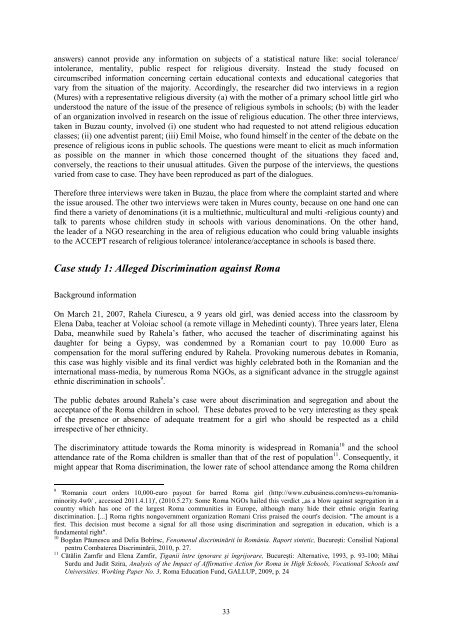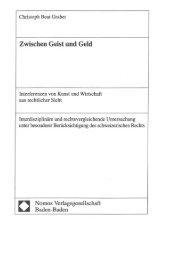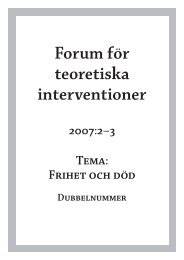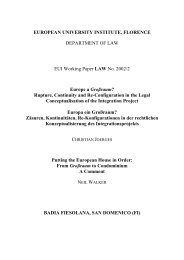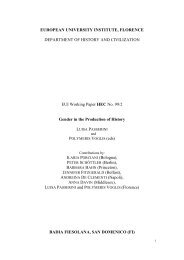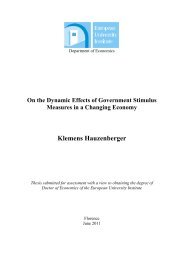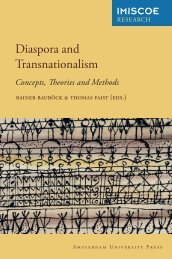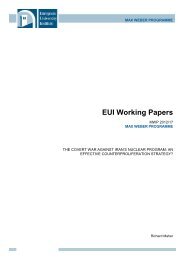Sinziana-Elena Poiana Ioana Lupea Irina-Madalina Doroftei Alina ...
Sinziana-Elena Poiana Ioana Lupea Irina-Madalina Doroftei Alina ...
Sinziana-Elena Poiana Ioana Lupea Irina-Madalina Doroftei Alina ...
You also want an ePaper? Increase the reach of your titles
YUMPU automatically turns print PDFs into web optimized ePapers that Google loves.
answers) cannot provide any information on subjects of a statistical nature like: social tolerance/<br />
intolerance, mentality, public respect for religious diversity. Instead the study focused on<br />
circumscribed information concerning certain educational contexts and educational categories that<br />
vary from the situation of the majority. Accordingly, the researcher did two interviews in a region<br />
(Mures) with a representative religious diversity (a) with the mother of a primary school little girl who<br />
understood the nature of the issue of the presence of religious symbols in schools; (b) with the leader<br />
of an organization involved in research on the issue of religious education. The other three interviews,<br />
taken in Buzau county, involved (i) one student who had requested to not attend religious education<br />
classes; (ii) one adventist parent; (iii) Emil Moise, who found himself in the center of the debate on the<br />
presence of religious icons in public schools. The questions were meant to elicit as much information<br />
as possible on the manner in which those concerned thought of the situations they faced and,<br />
conversely, the reactions to their unusual attitudes. Given the purpose of the interviews, the questions<br />
varied from case to case. They have been reproduced as part of the dialogues.<br />
Therefore three interviews were taken in Buzau, the place from where the complaint started and where<br />
the issue aroused. The other two interviews were taken in Mures county, because on one hand one can<br />
find there a variety of denominations (it is a multiethnic, multicultural and multi -religious county) and<br />
talk to parents whose children study in schools with various denominations. On the other hand,<br />
the leader of a NGO researching in the area of religious education who could bring valuable insights<br />
to the ACCEPT research of religious tolerance/ intolerance/acceptance in schools is based there.<br />
Case study 1: Alleged Discrimination against Roma<br />
Background information<br />
On March 21, 2007, Rahela Ciurescu, a 9 years old girl, was denied access into the classroom by<br />
<strong>Elena</strong> Daba, teacher at Voloiac school (a remote village in Mehedinti county). Three years later, <strong>Elena</strong><br />
Daba, meanwhile sued by Rahela’s father, who accused the teacher of discriminating against his<br />
daughter for being a Gypsy, was condemned by a Romanian court to pay 10.000 Euro as<br />
compensation for the moral suffering endured by Rahela. Provoking numerous debates in Romania,<br />
this case was highly visible and its final verdict was highly celebrated both in the Romanian and the<br />
international mass-media, by numerous Roma NGOs, as a significant advance in the struggle against<br />
ethnic discrimination in schools 9 .<br />
The public debates around Rahela’s case were about discrimination and segregation and about the<br />
acceptance of the Roma children in school. These debates proved to be very interesting as they speak<br />
of the presence or absence of adequate treatment for a girl who should be respected as a child<br />
irrespective of her ethnicity.<br />
The discriminatory attitude towards the Roma minority is widespread in Romania 10 and the school<br />
attendance rate of the Roma children is smaller than that of the rest of population 11 . Consequently, it<br />
might appear that Roma discrimination, the lower rate of school attendance among the Roma children<br />
9 'Romania court orders 10,000-euro payout for barred Roma girl (http://www.eubusiness.com/news-eu/romaniaminority.4w0/<br />
, accessed 2011.4.11)', (2010.5.27): Some Roma NGOs hailed this verdict „as a blow against segregation in a<br />
country which has one of the largest Roma communities in Europe, although many hide their ethnic origin fearing<br />
discrimination. [...] Roma rights nongovernment organization Romani Criss praised the court's decision. "The amount is a<br />
first. This decision must become a signal for all those using discrimination and segregation in education, which is a<br />
fundamental right".<br />
10 Bogdan Păunescu and Delia Bobîrsc, Fenomenul discriminării în România. Raport sintetic, Bucureşti: Consiliul Naţional<br />
pentru Combaterea Discriminării, 2010, p. 27.<br />
11 Cătălin Zamfir and <strong>Elena</strong> Zamfir, Ţiganii între ignorare şi îngrijorare, Bucureşti: Alternative, 1993, p. 93-100; Mihai<br />
Surdu and Judit Szira, Analysis of the Impact of Affirmative Action for Roma in High Schools, Vocational Schools and<br />
Universities. Working Paper No. 3, Roma Education Fund, GALLUP, 2009, p. 24<br />
33


